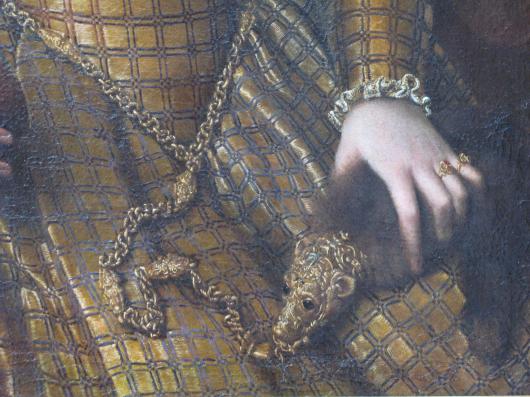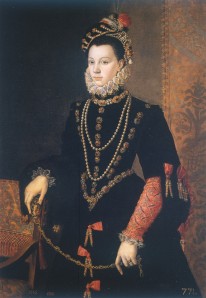 A zibellino, from the Italian for “sable,” is a pelt from one of the mustelids (sable, marten, ermine) worn draped at the neck or hanging at the waist, or carried in the hand; a women’s fashion accessory popular in the later 15th & 16th centuries. Some zibellini were fitted with faces & paws of goldsmith’s work with jeweled eyes & pearl earrings, while unadorned furs were also fashionable. Although it had been suggested that the furs were intended to attract fleas away from the body of the wearer, that appears to be merely urban, or perhaps, feudal legend.
A zibellino, from the Italian for “sable,” is a pelt from one of the mustelids (sable, marten, ermine) worn draped at the neck or hanging at the waist, or carried in the hand; a women’s fashion accessory popular in the later 15th & 16th centuries. Some zibellini were fitted with faces & paws of goldsmith’s work with jeweled eyes & pearl earrings, while unadorned furs were also fashionable. Although it had been suggested that the furs were intended to attract fleas away from the body of the wearer, that appears to be merely urban, or perhaps, feudal legend.
The sartorial taxonomy represented by the codification of sumptuary laws (sumptuariae leges), especially during the Renaissance, preserved the demarcations of class distinction. We wouldn’t want just anyone to wear a zibellino! And so we find the likes of Mary Queen of Scots & Elizabeth I of England wearing their sable zibellini, while those of lesser standing could wear fur pieces more suited to their station, de facto.
 Cremonese court painter to Philip II of Spain, Sofonisba Anguissola (c.1532-1625), includes several zibellini in her works. The detail from the painting above is from a portrate of Bianca Ponzoni, Anguissola’s step-mother, painted in 1557. Perhaps the most famous is her portrait of Queen Elisabeth of Valois with the pelt of a marten set with a head & feet of jewelled gold. (It was the most widely copied portrait in Spain; copied by artists such as Peter Paul Rubens).
Cremonese court painter to Philip II of Spain, Sofonisba Anguissola (c.1532-1625), includes several zibellini in her works. The detail from the painting above is from a portrate of Bianca Ponzoni, Anguissola’s step-mother, painted in 1557. Perhaps the most famous is her portrait of Queen Elisabeth of Valois with the pelt of a marten set with a head & feet of jewelled gold. (It was the most widely copied portrait in Spain; copied by artists such as Peter Paul Rubens).
Although carrying zibellini as a fashion statement died out in the 17th century, fox & mink pelts were worn in similar fashion in the 19th & 20th century. But be not dismayed. You too may carry a zibellini (although preferably not to a PETA meeting), as advertized by Sable Greyhound:
‘Your zibellino will be made to order. You get to choose your:
- Type of fur: I always have mink or marten on hand. Also, I will occasionally I have fox and sable pelts available as well.
- Color of “metal”: My zibie’s heads and feet are made of a durable polymer clay, which is much lighter weight and economical than real gold or silver. You have your choice of gold, silver, copper, black, or pearl. Other colors available upon request.
- Decorations: Gold or silver filigree & your choice of crystal colors for the collar, eyes & overall ornamentation. (Actual layout of decoration will be up to my discretion.)

Included is a photo of my own personal zibellino. Actually, it’s a mink’s head from a stole I purchased at a “flea market,” then mounted on a small 3×5″ plaque in order to parody a relative’s trophy room.
Sherrill, Tawny “Fleas, Furs, & Fashions: Zibellini as Luxury Accessories of the Renaissance,” in Robin Netherton & Gale R. Owen-Crocker, editors, Medieval Clothing & Textiles, Vol 2, p. 121-50
Facelle, Amanda E. “Sumptuary Law & Conspicuous Consumption in Renaissance Italy,” BA Thesis, Wesleyan University 2009
Basic Chart of Tudor Sumptuary Laws for Dress
